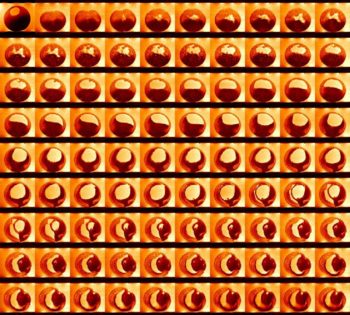Biophysics: Difference between revisions
imported>Daniel Mietchen m (phrasing) |
imported>Daniel Mietchen (+image) |
||
| Line 1: | Line 1: | ||
{{subpages}} | {{subpages}} | ||
{{Image|Magnetic resonance microscopy montage embryo.png|right|350px|Biophysics studies [[life|living system]]s with the methods of [[physics]]: A [[montage]] of [[in vivo]] images acquired by means of [[magnetic resonance microscopy]] from a [[Developmental stages of Xenopus laevis|stage VI]] ([[prophase I]]-arrested) [[oocyte]] (top left frame) and the [[embryogenesis]] in the frog [[Xenopus laevis]], from shortly after the first [[cell division]] until shortly prior to the [[hatching]] of the [[tadpole]].}} | |||
'''Biophysics''' is a branch of [[science]] concerned with the experimental and theoretical study of [[biology|biological systems]] using the background and concepts of [[physics]] and [[mathematics]]. This means that most of the methods used in biophysical research also originate from those fields. Nevertheless, biophysics has in its many subfields developed its own theories, which form the core of the curriculum in any institute teaching it. | '''Biophysics''' is a branch of [[science]] concerned with the experimental and theoretical study of [[biology|biological systems]] using the background and concepts of [[physics]] and [[mathematics]]. This means that most of the methods used in biophysical research also originate from those fields. Nevertheless, biophysics has in its many subfields developed its own theories, which form the core of the curriculum in any institute teaching it. | ||
Revision as of 17:57, 3 December 2009

Biophysics is a branch of science concerned with the experimental and theoretical study of biological systems using the background and concepts of physics and mathematics. This means that most of the methods used in biophysical research also originate from those fields. Nevertheless, biophysics has in its many subfields developed its own theories, which form the core of the curriculum in any institute teaching it.
Biophysics is often also used loosely in neighbouring biological sciences (as in biochemistry) to describe some quantitative aspect of a biological phenomenon, such as the biophysics of proteins (meaning how physical laws define their structure or changes thereof) or cell membranes (meaning electrical signalling phenomena and mathematics of the factors creating it).
Research themes in biophysics encompass all major characteristics of life, namely homeostasis, compositionality, metabolism, growth, adaptation, irritability and reproduction. Hence, they cover all levels of biological organization, from the atomic and molecular level via cells, organs and tissues to individual organisms, populations, species, ecosystems, the biosphere, and astrobiology. Methodologically, biophysics employs a wide range of experimental and theoretical techniques from neighbouring scientific disciplines, as long as they are applicable to the scale of interest and compatible with the biological objects under study. A large part of modern biophysics make extensive use of computational facilities to calculate molecular structures and interaction, to simulate physiological functions of cardiac or neural cells, or calculate information content, transmission and transformations in biosystems.